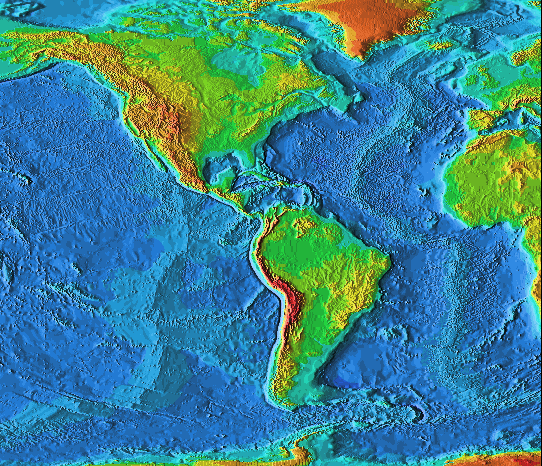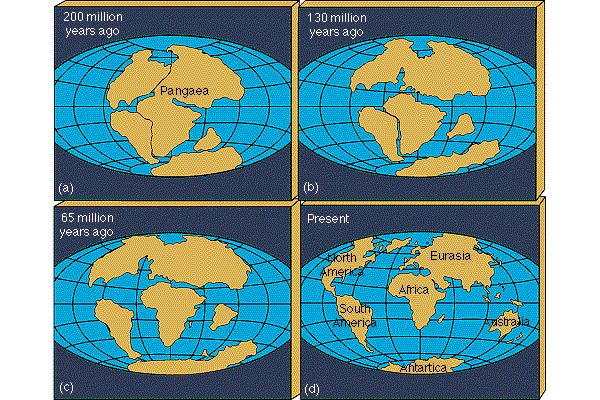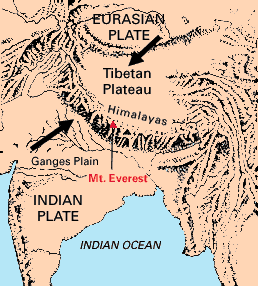PLATE TECTONICS
Alfred Wegener (1915)
proposed that in the past there had been
only one supercontinent,
Pangaea. Three hundred million years ago (or so),
Pangaea broke up and the pieces began
to drift apart.
Strong support for this hypothesis comes from
fossils found in South America and Africa which
indicate that the regions had
similar lifeforms and from fossils which indicate that tropical lifeforms
existed in Antarctica around
200 million years ago. Further evidence is provided by
paleomagnetism [the study of the Earth's magnetic field.]
The continents currently
drift apart at a rate of 2 to 4 cm per year. Today, we can determine this rate
using Global Positioning Satellites (GPS). In the past, methods based on
paleomagnetism were often used and other methods also looking at places where
plates moved apart (divergent plate boundaries) were used. |


|
One of the reasons that this
idea, which seems so compelling, was not initially accepted
was that no one could imagine how things like continents
could move around (or more precisely, what could push continents
around). There also was no direct evidence that continents
were moving (paleomagnetism did not take hold until the 1960s).
Today, we have a reasonable idea for the mechanism that drives
planet tectonics.
Recall that the interior of the Earth is hot and that it can be divided
into the core, mantle, and crust, based upon chemical
differences but that
from a mechanical standpoint,
it was better to consider the crust and the
outer part of the mantle
as one unit, the
lithosphere
and the plastic layer underneath as
one unit, the
asthenosphere.
Some properties of the lithosphere are as
follows:
- The lithosphere is less than ~ 100 km in thickness
- The lithosphere is composed of two types of material
distinct in
composition and structure; the oceanic crust (55 %) and the continental
crust (45 %).
- The oceanic crust is thin (< 6 km) and is composed of basalts,
similar
to those found in lunar maria. The oceanic crust is denser than the
continental crust.
- The continental crust is thicker
(~ 20 - 70 km) and is composed of
granites. Granites (as are the basalts) are igneuous rocks, however,
granites
were formed under high pressure below the surface of the Earth.
The continental crust is less dense than the oceanic crust.
- The lithosphere is not one unit, it is
segmented. It is
composed
of 7 major plates and around
two dozen smaller ones. The places
where the
plates come together are well-marked as regions of enhanced geological
activity.
There
are three types of
plate boundaries: (1) divergent plate boundaries where plates move apart;
(2) convergent plate boundaries where plates collide; and
(3) transform plate boundaries where plates slide along each other.
The lithospheric plates are moved around by
convective motions
(e.g.,
Oatmeal convection,
horizontal motion
).
Because the Earth is
hottest at its center and cools as one moves outward an outward flow of
heat is set up.
The heat is carried by
conduction in the lithosphere.
The heat is
carried by
convection in the asthenosphere.
 |
The large scale circulations (motions) in the asthenosphere
move the overlying lithospheric plates on the surface of the Earth
leading to the continental drift observed today.
|
Lithospheric plates separate near rifts
(divergent plate boundaries), places where new crust
is produced. There is a large
rift in the mid-Atlantic stretching from Iceland to Antarctica,
the mid-Atlantic Ridge.
Overall, there are around 60,000 km of active rifts
on the surface of the Earth.
Most rifts are in the oceans but some are on land, e.g.,
the Great Rift Valley in Africa. New crust is created continuously.
PLATE BOUNDARIES
Because the Earth is not growing in size while
crust is created continuously,
crustal material must also be destroyed continuously. To see where
and how this occurs look at the interactions where plates meet.

Divergent Plate Boundaries
- rift zones
or spreading centers occur where plates separate
(see the Mid-Atlantic Ridge). The upswelling
convective motions in the asthenosphere push the plates
apart and the upwelling lava cools forming basaltic rock. In
addition to this new crust, heat and minerals are also deposited.
The oceanic crust varies in age from very young near a rift
to roughly 100 million years or so far away.
(The oldest oceanic crust found has been around
180 million years old.) The age of oceanic crust is thus much
smaller than the age of the Earth which is around 4.5 billion
years.
Convergent Plate Boundaries
- subduction zones:
 |
Subduction zones occur where continental plates meet oceanic
plates (note that the oceanic basin spreading from the
mid-Atlantic ridge
pushes the North American and South American plates, there is
no subduction zone at the eastern coasts of North and South America).
Because the oceanic plates are denser and thinner than are the
continental plates, they are forced inward (into the Earth). The
oceanic plates are forced downward to the regions of high
temperature where the rocks melt
(around 200 - 300 km below the surface).
Some of the released material returns to the surface via
volcanos while most is recycled into the mantle coming out
in rift zones.
Near subduction
zones you find oceanic trenches, mountain ranges,
volcanism, and earthquakes.
|
Of particular interest to us is the
Juan de Fuca plate
which forms a shallow angle
subduction zone. Shallow angle subduction zones lead to
violent activity, such as earthquakes and volcanism. In Oregon, we get large
earthquakes every 500 years or so. The last happened at 9 pm on
January 26, 1700, the Cascadia earthquake,
magnitude 8.7-9.2. This is large; a magnitude 6 earthquake has 1 Megaton of
seismic energy. A magnitude 7 earthquake has 32 Megatons of seismic energy.
A magnitude
8 earthquake has 1,000 Megatons of seismic energy. A magnitude 9 earthquake
has 32,000 Megatons of seismic energy! We are roughly due for a large
earthquake.
 |
When two continental plates collide, because
there is no strong tendency for one plate to slide under the other, the
plates tend to crumple or crease and we get
mountain range
formation.
An example of this is the
Himalayan mountain range. |
 |
Transform Plate Boundaries
- transform faults
occur where two plates slide parallel to each other.
An example of this is the
San Andreas fault
in California. The Pacific
plate is forced northward at a rate of a few centimeters per year with
respect to most of the North American plate
(map).
At this rate, Los Angeles
will be next to San Francisco in about 20 million years. Earthquakes
occur near
fault lines because the plates do not slide smoothly. There is friction
between the plates which causes the motion to go in fits and spurts.
The San Andreas fault lets go every century or so. The last
big earthquake occured in
1906 in San Francisco where the
plates slipped by around 6 m (the 1989
earthquake relieved less than 3 m of stress). The southern section
moves about 7 m in a large earthquake
and hasn't really let go since the
great Fort Tejon earthquake of 1857. This is a concern.
Comment:
The Hawaiian Islands represent a different kind of volcanism (compared to
the volcanos found, e.g., in the Cascades).
They do not occur near plate boundaries.
They are formed near a hot-spot in the mantle of the Earth.
Through so-called
plumes, magma rises to the surface of the Earth.
The magma oozes to the surface
forming what are known as
shield volcanos (as opposed to stratovolcanos).
Shield volcanos have gradual slopes and are produced by
lava flows building
on each other. The Hawaiian islands are the
largest volcanos
on the Earth
having bases with diameters of ~ 200 km (120 mi) and
heights of 9 km (the volcano on the Big Island,
Mauna Loa,
is the largest active
volcano on the Earth). The reason that there is an island chain is due to the
fact that the Pacific plate is moving (at a rate of a few cm per year).
In one or two million years the Pacific plate moves a distance equal
to the average distance
the islands. The Hawaiian island chain thus represents a
time sequence
with the Big Island being the youngest. This process continues to today
and to ancient
times. There is another Hawaiian island forming,
Loihi,
about 20 km southeast of the Big Island.
Loihi is currently about a kilometer below the surface of the Pacific.
It is expected to make its appearance in 50,000 years or so.








